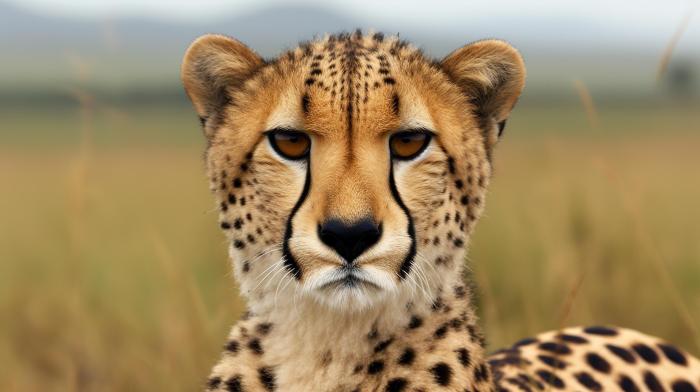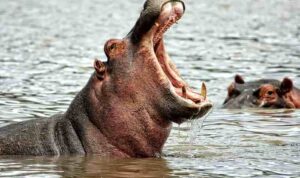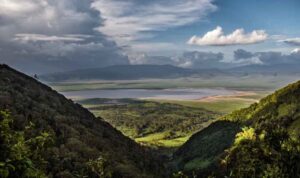Cheetah, known for its unmatched speed and striking appearance, roams the vast savannah with grace and agility, captivating all who witness its prowess. Dive into the world of this majestic feline as we explore its unique traits and behaviors.
Physical Characteristics: Cheetah

Cheetahs are known for their sleek and slender appearance, with a long, slim body and a small, rounded head. They have distinctive black “tear tracks” running from the inner corners of their eyes down to the sides of their mouths. These tear tracks help reduce glare from the sun and improve their vision during hunting.
Adaptation for Speed
Cheetahs are built for speed, with long, powerful legs and a flexible spine that allows for increased stride length. Their lightweight build, with a reduced number of bones and a smaller heart than other big cats, helps them achieve incredible speeds of up to 60-70 miles per hour in short bursts. Additionally, their large nasal passages and lungs enable efficient oxygen intake during high-speed chases.
Unique Coat Features
One of the most striking features of a cheetah’s coat is the presence of solid black spots on a tan or golden background. These spots are not just for camouflage but also aid in breaking up their Artikel, making them less visible to prey. The coat also has a unique texture, with each hair being coarse and hollow, providing insulation and reducing drag when running at high speeds.
Habitat and Range

The habitat and range of cheetah populations play a crucial role in their survival and conservation efforts. Here, we explore where these magnificent creatures are typically found and how habitat loss is impacting their populations.
Typical Habitats
Cheetahs are primarily found in the savannas, grasslands, and semi-arid regions of Africa. These habitats provide the open spaces and vegetation that cheetahs need for hunting and survival. They are also known to inhabit some parts of Iran in Asia.
Geographical Range
The geographical range of cheetah populations extends across several countries in Africa, including Namibia, Botswana, South Africa, Kenya, and Tanzania. In Asia, cheetahs were historically found in Iran, but their population has drastically declined.
Impact of Habitat Loss
Habitat loss due to human activities such as agriculture, urbanization, and deforestation is a significant threat to cheetah populations. As their natural habitats shrink, cheetahs face increased competition for resources, fragmentation of their territories, and conflicts with humans.
Behavior and Social Structure

When it comes to behavior and social structure, cheetahs exhibit fascinating characteristics that contribute to their survival in the wild.
Hunting Behavior
Cheetahs are known for their exceptional hunting abilities, relying on their incredible speed and agility to chase down prey. They are built for short bursts of high-speed running, reaching speeds of up to 60-70 mph in a matter of seconds. Unlike other big cats, cheetahs rely on speed rather than strength to catch their prey. They often hunt during the day and primarily target small to medium-sized ungulates such as gazelles and impalas. The chase itself is short-lived, lasting only about 20-30 seconds before the cheetah either catches its prey or gives up due to exhaustion.
Social Structure
Cheetahs are typically solitary animals, with adult males being the most solitary of the species. Females, on the other hand, may form small groups consisting of a mother and her sub-adult offspring. These groups are usually temporary and disband once the offspring are old enough to fend for themselves. While cheetahs may not form long-lasting social bonds like some other big cats, they do exhibit some level of social behavior, especially during breeding and when raising young.
Communication
Cheetahs communicate with each other through a variety of vocalizations, body language, and scent marking. They use vocal cues such as chirps, growls, and purring sounds to convey messages to one another. Body language, including postures and facial expressions, also play a significant role in communication among cheetahs. Additionally, cheetahs mark their territories with urine, feces, and scratching on trees to communicate with other individuals in the area. This helps establish boundaries and avoid conflicts with neighboring cheetahs.
Conservation Status

Cheetahs are currently listed as vulnerable on the IUCN Red List of Threatened Species. The global population of cheetahs has been declining rapidly due to various threats they face in the wild.
Main Threats to Cheetah Populations
- Habitat Loss: The expansion of human settlements, agriculture, and infrastructure development has led to the loss of cheetah habitats.
- Human-Wildlife Conflict: Cheetahs often come into conflict with humans over livestock, leading to retaliatory killings by farmers.
- Illegal Wildlife Trade: Cheetahs are sometimes captured for the illegal wildlife trade, where they are sold as exotic pets or for their skin and body parts.
- Climate Change: Changing environmental conditions can impact the availability of prey species for cheetahs, affecting their survival.
Conservation Efforts to Protect Cheetahs
- Protected Areas: Establishing and managing protected areas and national parks where cheetahs can thrive undisturbed.
- Community Engagement: Working with local communities to raise awareness about the importance of conserving cheetahs and implementing measures to reduce human-wildlife conflict.
- Anti-Poaching Efforts: Strengthening anti-poaching measures to combat the illegal trade in cheetahs and their body parts.
- Captive Breeding Programs: Implementing captive breeding programs to increase cheetah populations and genetic diversity.
As we conclude our exploration of the cheetah, we are left in awe of its beauty and resilience in the face of challenges. The future of this magnificent creature relies on our collective efforts to ensure its survival in the wild.






